I am very new to using TKinter. I am making a TKinter window that displays the descriptive statistics of the wine quality data sets. The problem I am having is with the positioning. Even using pack(side=BOTTOM), the button for the histogram shows up next to the column option buttons I have, like so:

Ideally, what I would like the window to look like, is similar to this:

I tried making the button in the same place I made the label "Descriptive statistics", and then configuring it later, but while that keeps the button where I would like it to be, the histogram ends up in the same place.
Edit: I was originally using grid() to manually place everything, but, for aesthetic reasons, I didn't like how the spaces in between the buttons would adjust as more objects were added to the window. I was also getting a "can't use pack() and grid()" warning even though I had changed all pack()s to grid()s, specifically only because of my plot function, and I couldn't figure it out. So in the end I just made the switch from grid() to pack() to avoid continually getting that error.
My code:
import tkinter as tk
from matplotlib.figure import Figure
from matplotlib.backends.backend_tkagg import (FigureCanvasTkAgg, NavigationToolbar2Tk)
#the main window
root = tk.Tk()
root.title('Descriptive statistics for vinho verde datasets')
#generate some labels
lbl1 = tk.Label(root, text = "Wine choice:")
lbl1.pack(side=TOP)
lbl2 = tk.Label(root, text = "Descriptive statistics:")
lbl2.pack(side=BOTTOM)
def wine_choice(opt):
#functions determining for which columns to output descriptive statistics
def describe(colm):
if opt == 'white':
res = white[colm].describe()
else:
res = red[colm].describe()
txt = "\nDescriptive statistics for {0} wine, {1}:\n\n{2}"
lbl2.config(text = txt.format(opt,colm,res))
def b_plot():
#figure that will contain the plot
fig = Figure(figsize = (5, 5), dpi = 75)
p1 = fig.add_subplot()
if opt == 'white':
p1.hist(white[colm])
else:
p1.hist(red[colm])
#creating the canvas containing figure and placing on the window
canvas = FigureCanvasTkAgg(fig, root)
canvas.draw()
canvas.get_tk_widget().pack(side=BOTTOM)
btn_p = tk.Button(root, command = b_plot, width=10, height=3, text = "Histogram").pack(side=BOTTOM)
lbl3 = tk.Label(root, text = "Pick an attribute to investigate:")
lbl3.pack(side=TOP)
#spawn attribute buttons after user chooses a wine
#generate buttons
btn3 = tk.Button(root, text='fixed acidity', width=10, height=3)
btn3.pack(side=LEFT)
btn3.bind('<Button-1>', lambda e: describe('fixed acidity'))
btn4 = tk.Button(root, text='volatile\nacidity', width=10, height=3)
btn4.pack(side=LEFT)
btn4.bind('<Button-1>', lambda e: describe('volatile acidity'))
btn5 = tk.Button(root, text='citric\nacid', width=10, height=3)
btn5.pack(side=LEFT)
btn5.bind('<Button-1>', lambda e: describe('citric acid'))
btn6 = tk.Button(root, text='residual\nsugar', width=10, height=3)
btn6.pack(side=LEFT)
btn6.bind('<Button-1>', lambda e: describe('residual sugar'))
btn7 = tk.Button(root, text='chlorides', width=10, height=3)
btn7.pack(side=LEFT)
btn7.bind('<Button-1>', lambda e: describe('chlorides'))
btn8 = tk.Button(root, text='free\nsulfur\ndioxide', width=10, height=3)
btn8.pack(side=LEFT)
btn8.bind('<Button-1>', lambda e: describe('free sulfur dioxide'))
btn9 = tk.Button(root, text='total\nsulfur\ndioxide', width=10, height=3)
btn9.pack(side=LEFT)
btn9.bind('<Button-1>', lambda e: describe('total sulfur dioxide'))
btn10 = tk.Button(root, text='density', width=10, height=3)
btn10.pack(side=LEFT)
btn10.bind('<Button-1>', lambda e: describe('density'))
btn11 = tk.Button(root, text='pH', width=10, height=3)
btn11.pack(side=LEFT)
btn11.bind('<Button-1>', lambda e: describe('pH'))
btn12 = tk.Button(root, text='sulphates', width=10, height=3)
btn12.pack(side=LEFT)
btn12.bind('<Button-1>', lambda e: describe('sulphates'))
btn13 = tk.Button(root, text='alcohol', width=10, height=3)
btn13.pack(side=LEFT)
btn13.bind('<Button-1>', lambda e: describe('alcohol'))
btn14 = tk.Button(root, text='quality', width=10, height=3)
btn14.pack(side=LEFT)
btn14.bind('<Button-1>', lambda e: describe('quality'))
#buttons for wine choices
btn1 = tk.Button(root, text = "white", width=10, height=2)
btn1.pack(side=TOP)
#remember which button user picks
btn1.bind('<Button-1>', lambda e: wine_choice('white'))
btn2 = tk.Button(root, text = "red", width=10, height=2)
btn2.pack(side=TOP)
btn2.bind('<Button-1>', lambda e: wine_choice('red'))
#must be called for window to be drawn and events to be processed
root.mainloop()